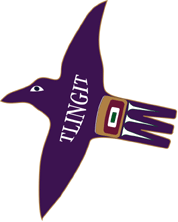 Tlingit Indians of Southeastern Alaska Tlingit Indians of Southeastern Alaska
APPENDIX H
RAVEN STORIES
Adapted from the versions in John R. Swanton's
Tlingit Myths and Texts, U.S. Government Printing
Office; Washington, D.C. 1909
Humor is probably the hardest thing to translate from one language
and culture to another.
And yet, one of the most humorous characters in the oral traditions
of all Alaska Native groups, Raven, translates without any difficulty.
Raven is a complex character. He embodies many of the attributes
we admire least in humans. He is arrogant, greedy, selfish, childish, easily
angered, deceitful. He causes mischief and sometimes gets his just come-uppance.
And yet, he is also a Creator. It was he who gave light to the
world, made dry land, caused tides to rise and fall, gave fresh water to the
world. Sometimes, in the same story, he is to be both revered and laughed at.
His type of two-sided character is called a "trickster". There are
tricksters in most world literatures, and Raven is the uniquely Alaskan one.
Because of his almost human combination of good and bad, people
feel a real affection for Raven. And when they watch real ravens hopping and
squawking about, grabbing food from seagulls, or sitting imperiously at the
top of a spruce tree, they are reminded of Raven's personality and deeds. A
person must have just the right balance of reverence and enjoyment of Raven.
There are many Raven stories, but only a few of them are presented
here. The first, "How Raven Stole the Light", was told in 1904 by
a man named DeKina'k, of the Box House. It was then reworded by John Swanton.
Following this version is a second version of the same story, this
time in the form of a radio play (reworked by Tom Lowenstein). Read the play
through to yourself. It is, perhaps, too complex for students to present, but
its poetic form makes it an excellent read-aloud selection for you.
The second Raven story, "Raven, the Old Woman of the Tides,
and the Sea Urchins" was also rewritten by Lownestein, as a puppet play.
It is extremely popular with 4th graders.
Following the puppet play is an adaptation of "Raven and
the Fog Woman". Feel free to duplicate this for students if you like.
The questions at the end of the booklet can be used in guided discussion.
Next comes Raven's Greed, a booklet containing two Raven
stories, "Raven Turns Himself into a Woman" and "Raven and the
Fish Hawk". Discussion questions and topics follow each.
A reprint of a story adapted by Henry Davis, Kake, from the
Tlingit version told by Robert Zuboff, appears next. It is entitled, "How
the Salmon Started Up the Rivers."
The final Raven story, "How Raven Became Black and Gave
Water to the World", has been put in a modern form, the comic book. The
story as presented here fits within the Tlingit tradition of "children's
stories". Children heard the Raven cycle from their elders over and over,
but when the youngsters extemporized or elaborated on them amongst themselves,
the stories became part of a game. Such elaboration was encouraged as long
as
Raven's personality was constant. Your own class might enjoy making up their
own stories, using Raven's greed, hunger, sneakiness, selfishness, and sense
of play in their stories.
TABLE OF CONTENTS
MATERIALS LIST & GOALS
SECTION 1: Tlingit
Country
SECTION 2:
Clans
SECTION 3: Summer
Camp
SECTION 4: Tlingit
Economy: Surplus
SECTION 5: Wrap
Up
APPENDIX A: Brief
Description of Tlingit Culture
APPENDIX B: A Sample
Winter Clan House
APPENDIX C: Northwest
Coast Materials in ASD AVS Center
APPENDIX D: Juvenile
Literature on Northwest Coast Cultures
APPENDIX E: Art
Bibliography
APPENDIX F: Northwest
Coast Cultures Bibliography
APPENDIX G: Schools
Which Own Northwest Coast Study Prints
APPENDIX H: Raven
Stories (reprints)
APPENDIX I: Recorded
Versions of Clan Crest Stories
APPENDIX J: Some
Northwest Coast Art Activities
|